München or Munich, with a population of some 1.5 million ( and nearly 6 million including its suburb towns), the capital of the state of Bavaria and the third largest city in Germany (after Berlin and Hamburg) was founded in early 12th century by some Benedictine monks:(the city's coat of arms still figures a bald-headed monk in a habit right under the city gate) and has been the seat of the Bavarian Dukes from 13th century on and in 1506 became the sole capital of Germany. It was also the centre of of Catholic Counter-Reformation ( the Catholic League. led by the Jesuits, was founded in Munich in 1609) intended to stem the rising tide of the Protestant Reformation movements started by such figures as John Wycliffe, Jan Hus, Huldrych Zwingli, John Calvin, Martin Luther and which eventually led to the so-called Thirty-Years War (1618-1848) which devastated entire regions of Central Europe, something which contributed to the break-up of the Holy Roman Empire. Its ruler gained the status of an Elector in the 17th century (1623) (one of 7 to heads of European states who were given the right to elect the Holy Roman Emperor). But a third of its population was wiped out during the bubonic plagues of 1634-35. From its founding until the end of the first World War in 1918, it was ruled by the influential Wittelsbach family of the Duchy of Bavaria and in 1314, Duke Louis IV, a native of Munich, was elected German king and 14 years later crowned as the Holy Roman Emperor. It's a city with a very complex history and has been a centre of arts, culture and science since the early 19th century, with the founding of the Kingdom of Bavaria in 1806 whose kings like Ludwig I started putting up some of the finest buildings and boulevards in the city we now see. But in the latter part of the 19th century, his son Ludwig II who also sponsored the works of Richard Wagner, preferred building fairy castles in Munich's outskirts. For a brief period after WWI, in February 1909, the German communists proclaimed the establishment of a Bavarian Soviet Republic in the city but it was quickly suppressed by the Freikorp after three month and since then Munich has become the hub of the conservative Nazi movement and was called Hauptstadt der Bewegung. Munich became the headquarters of the NSDAP (Nazi party) which seized control of the German government in 1933 and it was at Dachau, some 10 miles northwest of Munich that the Nazis built their first concentration camp for the Jews. It was also at Munich that Chamberlain, the British Prime Minister agreed shamelessly to the annexation of Czechoslovakia's Sudetenland region into Hitler's Third Reich. During WWII, Munich was subjected to heavy bombings by the Allies ( 71 air raids in 5 years) but recovered quickly enough to become the host city of the 1972 Summer Olympics, where the members of the Palestinian terrorist group called "Black September" perpetrated the so-called Munich massacre. Munich is also the home of BMW and the world renowned beer festival, the annual Oktoberfest.
The Deutsches Theater, a building built in the neo-Baroque style, close to my hotel, first opened in September 1896 was originally built for vaudilles and popular comedies and folk plays, balls and carnivals but was re-designed in 1939 by the Nazis but was partly destroyed by bombings during the WWII and only re-opened in 1951 and since the 1960s has been used for classic drama, ballet, operetta and classial concerts in addition to musicals.

The theater hall seats some 1,670 people and is now Germany's largest commercial theater for musicals. The whole complex contains not only a theater but also a cafe, shops and restaurant and a hotel

The current musical.
By accident, I bumped into its opening reception and was allowed entry without any invitation, presumably because I carried a camera and was mistaken for a photo-journalist.
Some of the actors and the actress welcoming the guests
Walking across to take up door duty
Sculpture at its courtyard
Pan, the god of revelry, with his pipe
Everywhere I went, I found trees and plants. It was voted one of the most livable cities in Europe by an organization using 139 items of evaluation.
The Germans love not only their beers, but also Italian food.
This is Karlplatz, the square marking the entry to the old town
Behind this gate is the pedestrian only shopping area
Just across the street is the high court building
Two young Spaniards visiting Munich who posed for me!
Three statuettes erected outside a building in memory of Professor Herbert Jensen, the "composer" who finalized the city's urban renewal plans in 1966
A bubbling fountain in front of a church built by Mathias Gasteiger in 1895, with a discus throwing child before him

Children having fun with the wild boar

Children having fun with the wild boar
How should I draw this?
Too tired trying to figure it out . They're Italian kids.
Another one who hasn't decided what to do yet
All kinds of fruit on sale,including such tropical varieties as mango and papayas and bananas: result of ubiquitous globalization which according to the latest survey show that today, 50% of the world's wealth is concentrated in the hands of 1% of its population!
But the flowers don't seem to care: they just grow and wither wherever and whenever they can or have to.
The Neuhauserstrasse: the paradigmatic shopping street which continues as Kaufingerstrasse after St. Michael's Church
The more commercial part of the street , now rebuilt with modern looking buildings which are however not permitted to be higher than the roofs of the older buildings.
Munich used to be a river port with a monopoly on the sale of salt in the middle ages
Munich is a stronghold of Catholicism. Everywhere one goes, one finds churches.
This is St Michael's Church, a Jesuit church, originally built in 1683-1597 by Duke William of Bavaria as a spiritual centre to spearhead the Counter Reformation,against the Protestants attack of the Roman Catholic Church. .
A closer look: on each of the nave is a statue of one of members of the Wittelsbach family which fpr centuries have been the rulers of Bavaria.
St. Michael giving the devil his last
Two angels giving the infant Jesus his crown
There's an international organ festival at the church from 4th to 18th October
The beautiful organ at the church
The beautiful organ at the church
closer
The altar from a wider perspective with a typical Roman dome
The font for holy water
a shrine for the Holy Mother

A closer look
Who could this lady in armor be? St. Ursula?
A pamphlet found at the church: Ignatius Loyola is a the Spanish founder of the Jesuit order: they were supposed to the fighters and warriors of Jesus Christ who spearheaded the Counter Reformation against the Protestant "heretics". If there were really a God as portrayed to us lay people by our religious leaders, I wonder what the Almighty thought when he saw Christians fighting cutting each others' throats or putting bullets into each others heart or head during the 30 Years War, and Christian soldiers fighting shelling or firing at each other during the WWI and WWII with priests, chaplains, pastors on each side praying that the soldiers from the opposite side would not kill their own soldiers whose express duty it was was to vanquish their counterparts.?
Another statue of St. Michael, with a spear in hand
The left side of the church
The tomb of Eugene Napoleon. He was the son
Josephine de Beauharnais and her first husband, Alexandre de Beauharnais
before she married Napoleon Bonaparte. Eugene later married a daughter
of King Maximilian I Joseph of Bavaria in 1806. This is a monument to
him.
Another statue on the wall
Autumn offerings standing on the steps of the altar
The font for holy water: Catholics are supposed to dip their right hand into the font and make the sign of the cross over their head to receive the blessings of Christ.
The Frauenkirche (The Cathedral of Our Dear Lady) close to the New Town Hall (photo from Internet)
The Cenotaph of King Louis IV , Holy Roman Emperor, (reg. 1294-1347) at Fauenkirche. This is almost like the family church of the Wittelsbach royal family. In its vault are the crypts of various members of the Wittelsbachslike William V, (reigning 1579 to 1597), Maximilian I, Elector of Bavaria (reg. 1597-1651), King Ludwig II of Bavaria(reg. 1864-1886) King Otto of Bavaria (reg. 1886-1913) and his younger brother Prince Leopold of Bavaria, king of Greece and Archduchess Gisela of Austria, the eldest surviving child of Emperor Francis Joseph. It also houses the crypts of various German cardinals like Cardinal Julius, Cardinal Joseph etc.
One of the cardinals
another one
a third
Cardinal Francis
A sword in the heart of Mary when her son died?
The Church has apparently been rebuilt but many of the materials from the old church have been retained.

The font for holy water
and decorations above entrance of the old church
and reliefs in stone
and the coat of arms of the Wittelsbach family?
old painting with their elaborate wood carvings
a most vivid reminder to all, a stopped clock on the left and an hour glass on the right
and scenes depicting Jesus in the Garden of Gethsemene and on the way to Calvary
St. Joseph and the child Jesus with an olive branch?
old doors

tinted glass


But these stone carvings look older
and so is this. How do they manage to paint on stones? Or is it plaster
These paintings on the wall of the crypt look like they might have come from Edvard Munch or his imitators. The crypt contains the tombs of the Archbishops of Munich and Freising and also various members of the Wittelsbach dynasty including Duke Louis V, (reg. 1347-1361), Duke Stephen II, (reg. 1347-1375), Duke John II, (reg. 1375-1397), Duke Ernest, (reg. 1397-1438), Duke William III, (reg. 1397-1435), Duke John IV, (reg. 1460-1463), Duke Sigismund, (reg. 1460-1467), Duke Albert IV, (reg. 1467-1508), Duke William IV, (reg. 1508-1550), Duke Albert V, (reg. 1550-1579) and King Ludwig III, (reg. 1912-1918).
But old or new, it's the same Christ who died on the cross. Did he do so in vain? Looking at the world today, I cannot say that that is not a distinct possibility.



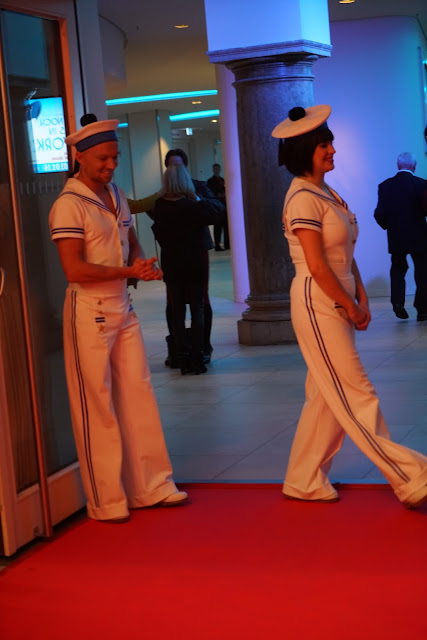















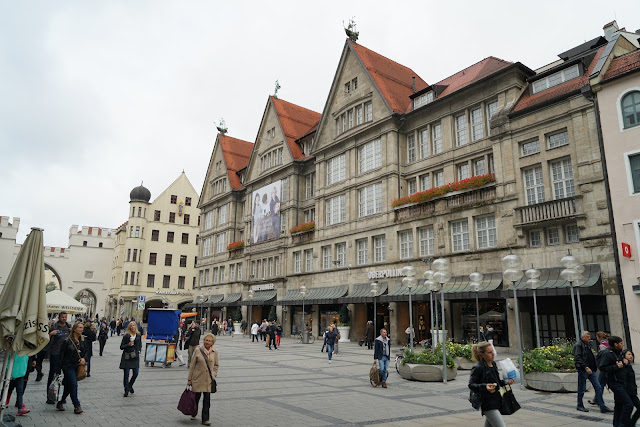























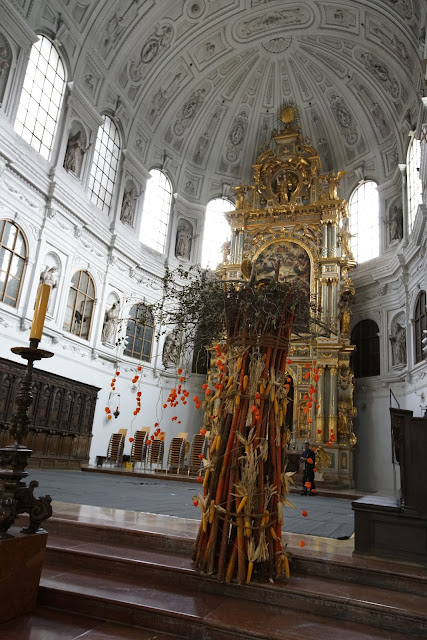






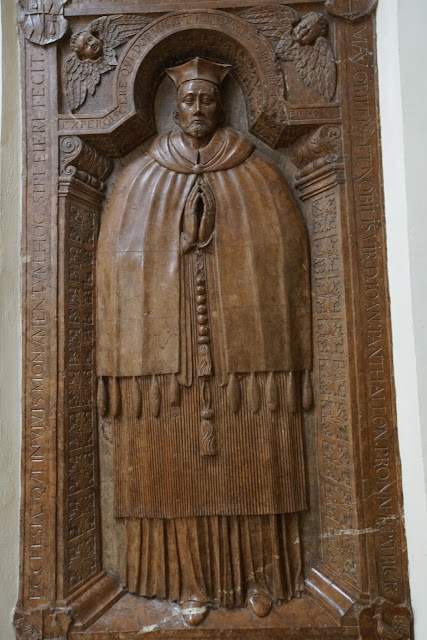









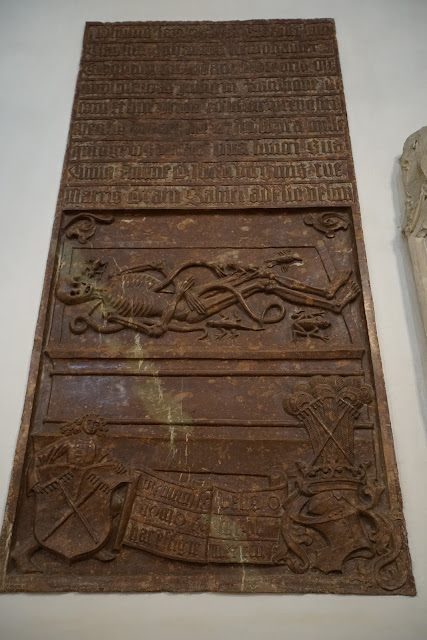

















沒有留言:
張貼留言